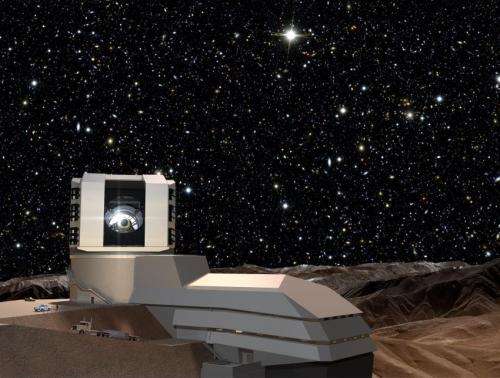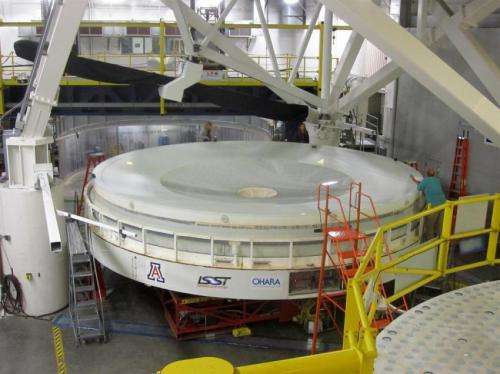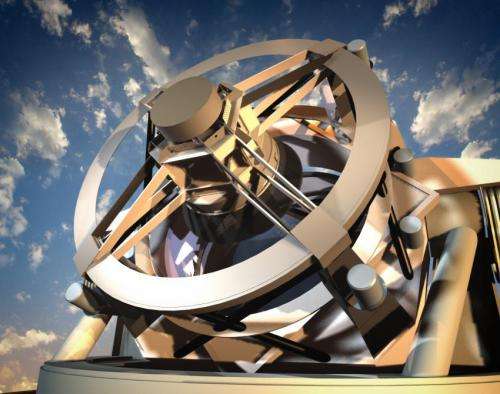UA optics at heart of telescope poised to catch the action in the universe

The National Science Foundation agreed on Friday to fund the construction of the Large Synoptic Survey Telescope project, the first observatory capable of scanning large swaths of night sky very quickly and capture exploding stars, passing asteroids and other highly variable, dynamic or short-lived phenomena in the universe.
Mirrors developed at the University of Arizona will form the heart of the revolutionary instrument, which will provide time-lapse digital imaging of faint astronomical objects across the entire sky, promising a deep and changing view of the cosmos.
LSST is the top-ranked major ground-based facility recommended by the National Research Council's Astronomy and Astrophysics decadal survey committee in its 2010 report "New Worlds, New Horizons." It is being carried out as an NSF and Department of Energy partnership, with NSF responsible for the telescope and site – Cerro Pachón in Chile – plus education and outreach and the data management system, and DOE providing the camera and related instrumentation. With the approved start occurring now, LSST will see first light in 2019 and begin full science operations in 2022.
Equipped with a 3-billion pixel digital camera – the largest digital camera to date – the telescope will scan the entire accessible sky every week, catching fleeting phenomena that astronomers call "variables in the process."
The night sky is filled with objects such as asteroids that dash across the sky and others – such as exploding stars and variable stars – that flash, dim and brighten. Studying such phenomena can help astronomers better understand the evolution of stars, massive black holes in the centers of galaxies, and the structure of the Milky Way.
"The strength of the LSST is its capability of mapping the sky over and over for 10 years," said Dennis Zaritsky, deputy director of the UA's Steward Observatory and professor of astronomy in the UA Department of Astronomy. "By being able to capture all the variables, the LSST really will usher in a new domain of science."
One type of variable objects, exploding stars called supernovae, were essential for the recent discovery of dark energy – the mysterious energy that dominates the expansion of the universe – that earned the 2011 Nobel Prize for three astronomers including UA alumnus Brian Schmidt, for discovering the accelerating expansion of the universe. Scientists expect LSST to discover other types of variables not yet known.

In order to be able to take multiple images of the sky in rapid succession, the LSST had to be designed radically different from other ground-based telescope of comparable size.
It began with the idea of designing a telescope with a wide field of view, proposed in the 1990s by Roger Angel, director of the UA's Steward Observatory Mirror Lab, in collaboration with Michael Lesser, who directs Steward Observatory's Imaging Technology Laboratory, and others, both at Steward Observatory and Lowell Observatory in Flagstaff, Arizona. Initial plans had the telescope scanning the sky for near-Earth objects, such as asteroids, that could pose an impact hazard to Earth.
"In order to do that, we needed a telescope that could quickly survey the sky over and over again to detect NEOs," Zaritsky said. "It had to be able to take a snapshot in each spot and move on. Therefore, the telescope had to be compact so it could move around quickly."
After the initial concept was born, "we realized we could do a lot more with such a telescope than search for NEOs," Zaritsky said.
Phil Pinto, associate professor in the UA Department of Astronomy, explained that being able to scan the sky – and take images – repeatedly would enable astronomers to systematically survey short-lived cosmic events such as supernovae.
The LSST's unique design was realized by manufacturing the 8.4-meter, or 27-foot, primary mirror with an integrated third mirror in its center that is about 5 meters, or 15 feet, in diameter.

"The traditional design of a large primary mirror with a small secondary mirror limits how big of a piece of sky you can see at any one time," Angel said. "Placing a third mirror inside the primary mirror and the detector instrument about halfway between the primary and secondary mirror gives you an about 10 times larger field of view."
Buell Jannuzi, director of Steward Observatory and head of the UA Department of Astronomy, stressed the importance of the initial support that kept the project moving forward toward the most recent milestone of federal funding, specifically by former Steward Observatory Director Peter Strittmatter, Bob Millis at Lowell, Sidney Wolff at National Optical Astronomical Observatory and the UA administration.
"We owe special recognition to Richard Caris, a member of the Arizona Astronomy Board and longtime supporter of UA astronomy efforts," Jannuzi said. "His continued attachment to the LSST mirror was evident in the number of times he visited the mirror lab to visit his mirror, as he would say."
"We have all of them, and the numerous contributions from many other locals at Steward Observatory and NOAO, to thank for getting LSST to where it is today," Jannuzi said.
"A unique aspect of this telescope is that the data will be made publicly available," Zaritsky said. "There are many of us at the UA – especially colleagues in physics, the Lunar and Planetary Lab and in astronomy – that are looking forward to using the data. We are in a position of competitive advantage relative to most researchers because we have access to other telescopes and planned new ones like the Giant Magellan Telescope that will enable us to follow up the most interesting discoveries from LSST with more in-depth observations."
More information: www.lsst.org/lsst/
Provided by University of Arizona



















